H13 Steel
now browsing by category
Why is H13 Steel Ideal for Hot Work Tool Applications?
H13 steel is one of the most widely used hot work tool steels, known for its exceptional performance in high-temperature environments. Classified as an air-hardening chromium-molybdenum-vanadium steel, H13 offers an excellent combination of heat resistance, toughness, and wear resistance.
Tool steels like H13 are crucial in industries that require durable and long-lasting tools, such as die casting, forging, and extrusion. Their ability to withstand extreme temperatures without losing mechanical integrity makes them the preferred choice for demanding applications.
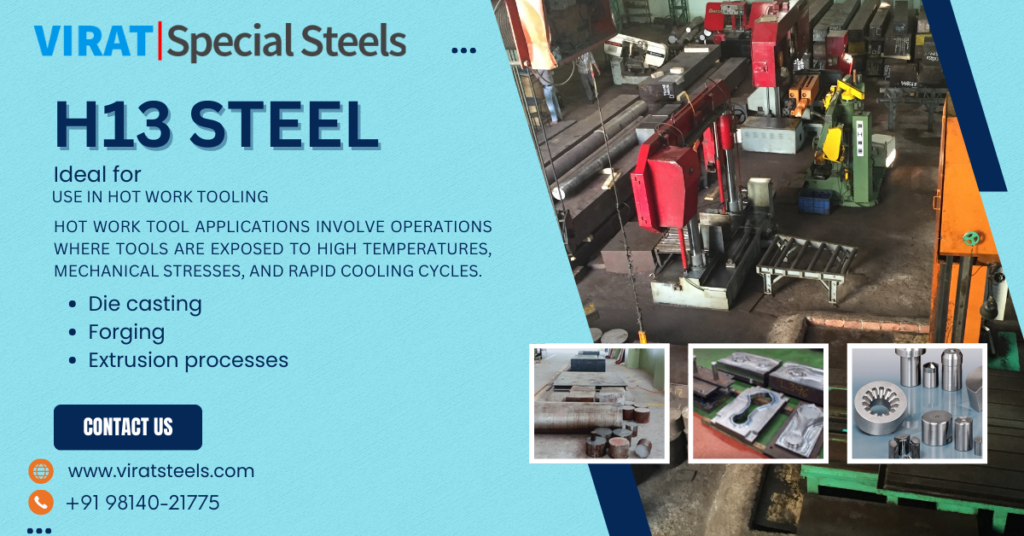
What Are Hot Work Tool Applications?
Hot work tool applications involve operations where tools are exposed to high temperatures, mechanical stresses, and rapid cooling cycles. These conditions demand materials that can maintain their properties without deformation, cracking, or excessive wear.
Industries Using Hot Work Tools
Several industries rely on hot work tools, including:
- Die casting – for producing metal components with intricate shapes
- Forging – shaping metals under extreme pressure
- Extrusion – forming materials into continuous profiles
- Plastic molding – high-heat plastic injection processes
Challenges in Hot Work Environments
Hot work tools face significant challenges, such as:
- High-temperature exposure leading to softening
- Thermal fatigue causing cracks
- Abrasive wear from repeated contact with molten metals
- Mechanical stress-induced failure
This is where H13 steel shines, offering unparalleled resistance to these harsh conditions.
Key Properties of H13 Steel
High Heat Resistance
H13 steel can endure temperatures up to 600°C (1112°F) without losing hardness. This makes it ideal for tools that come into direct contact with molten metals and other high-temperature environments.
Excellent Toughness and Ductility
Toughness is a critical factor in preventing cracking and chipping in hot work tools. H13’s balanced alloy composition provides excellent impact resistance, ensuring tools can withstand mechanical shocks and stress without failure.
Superior Wear Resistance
H13 offers outstanding wear resistance due to its alloying elements, particularly chromium and vanadium. This helps tools maintain their shape and performance over extended periods, reducing downtime and replacement costs.
Good Thermal Conductivity
Efficient heat dissipation is crucial in preventing overheating and thermal fatigue. H13 steel’s thermal conductivity allows it to distribute heat evenly, reducing localized stress and extending tool life.
High Hardenability and Stability
H13 retains its mechanical properties even after repeated heating and cooling cycles. It undergoes heat treatment effectively, ensuring a consistent hardness level and making it easier to machine.
Applications of H13 Steel in Hot Work Tools
Die Casting Molds
Die casting molds require materials that can withstand molten metal injections at high speeds and pressures. H13 steel’s resistance to heat checking and wear makes it ideal for casting aluminum, zinc, and magnesium.
Forging Dies
H13 is widely used in hammer and press forging dies, where it must endure extreme pressure and temperature fluctuations. Its ability to resist thermal fatigue helps prevent premature failure.
Extrusion Dies
Metal extrusion processes generate intense heat and stress. H13 steel ensures dimensional accuracy and prolonged die life, making it the go-to choice for aluminum and steel extrusion dies.
Plastic Molding Dies
In plastic injection molding, molds are subjected to repeated heating and cooling. H13’s stability ensures it can handle continuous cycles without deforming, making it perfect for high-volume production.
Comparing H13 Steel with Other Tool Steels
| Property | H13 Steel | D2 Steel | A2 Steel | P20 Steel |
| Heat Resistance | High | Medium | Low | Medium |
| Wear Resistance | High | Very High | Medium | Low |
| Toughness | High | Low | High | Medium |
| Thermal Conductivity | High | Low | Medium | High |
| Applications | Hot work | Cold work | General-purpose | Plastic molds |
H13 stands out as the best choice for hot work applications, offering a balance of wear resistance, toughness, and heat resistance.
Conclusion
H13 steel is a top-tier material for hot work tool applications, thanks to its:
- Exceptional heat resistance for high-temperature environments
- Toughness and durability to withstand mechanical stress
- Superior wear resistance for prolonged tool life
- Thermal stability to prevent overheating and deformation
With its outstanding properties, H13 remains the preferred steel for industries requiring high-performance hot work tools.
Mode of Supply
Virat Special Steels is the largest stockiest and supplier of H13 tool steel in flat, square and round bar. We provide steel in all sizes as your requirements. H13 die steel is available in flat, square and round shape. Consult our team who will assist you for h13 steel query.
FAQs
- What makes H13 better than other tool steels for hot work applications?
- H13 offers a superior combination of heat resistance, toughness, and wear resistance, making it ideal for demanding applications.
- Can H13 steel be used for cold work applications?
- While possible, H13 is specifically designed for hot work applications and may not perform as well in cold work environments.
- What is the typical hardness range of H13 steel after heat treatment?
- After proper heat treatment, H13 steel can achieve a hardness of 48-52 HRC.
- How does H13 resist thermal fatigue in die casting?
- H13’s heat resistance and thermal conductivity prevent cracking and deformation in extreme temperatures.
- What industries benefit the most from H13 steel?
Die casting, forging, extrusion, and plastic molding industries rely on H13 for durable tooling solutions.
What is H13 Steel and Its Applications?
Introduction
When it comes to materials that can withstand extreme conditions, H13 steel stands out as a top contender. This versatile chromium-molybdenum hot work tool steel is renowned for its exceptional combination of toughness, hardness, and resistance to thermal fatigue. Its unique properties make it indispensable across various industries, from automotive to aerospace.
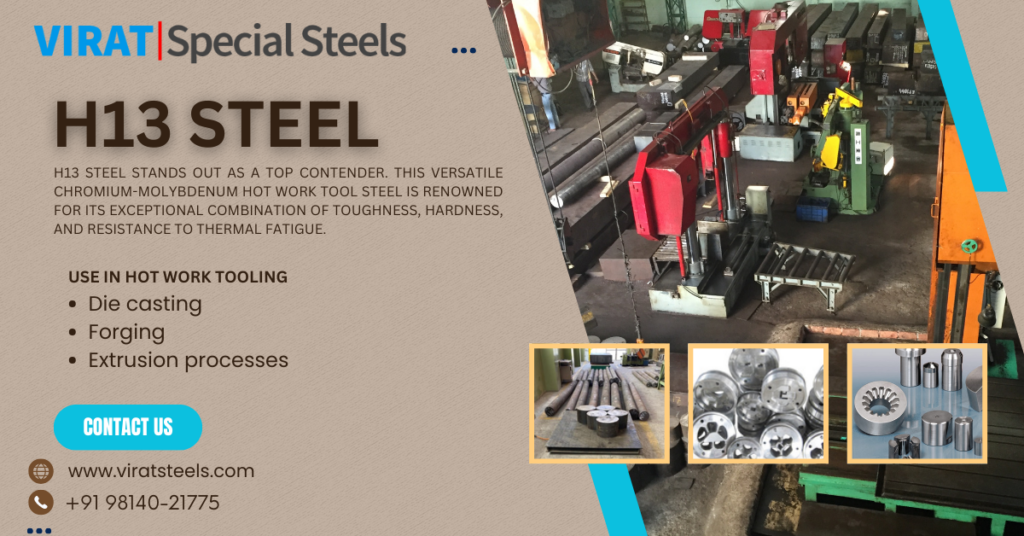
Chemical Composition of H13 Steel
The remarkable characteristics of H13 steel are rooted in its specific chemical makeup. The typical composition includes:
- Carbon (C): 0.32 – 0.40%
- Chromium (Cr): 5.13 – 5.25%
- Molybdenum (Mo): 1.33 – 1.4%
- Vanadium (V): 1.0%
- Silicon (Si): 1.0%
- Manganese (Mn): 0.20 – 0.50%
Each element plays a pivotal role:
- Carbon enhances hardness and strength.
- Chromium improves hardenability and resistance to oxidation.
- Molybdenum increases toughness and high-temperature strength.
- Vanadium contributes to wear resistance and grain refinement.
- Silicon boosts strength and elasticity.
- Manganese aids in deoxidation during steel production.
This balanced composition ensures that H13 steel maintains its integrity under demanding conditions.
Physical Properties of H13 Steel
Understanding the physical properties of H13 steel provides insight into its performance in various applications:
- Density: Approximately 7.80 g/cm³ (0.282 lb/in³)
- Thermal Conductivity: 24.3 W/m-K at 215°C (419°F)
- Coefficient of Thermal Expansion: 11.0 µm/m-°C between 25°C and 95°C
These properties indicate that H13 steel can efficiently conduct heat while maintaining dimensional stability, crucial for tools exposed to rapid temperature changes.
Mechanical Properties of H13 Steel
The mechanical prowess of H13 steel is evident in its ability to withstand substantial stress without deformation:
- Hardness: Rockwell C scale hardness ranges from 28 to 53, depending on heat treatment.
- Tensile Strength: Ultimate tensile strength can reach up to 1990 MPa (289,000 psi).
- Toughness: Demonstrates excellent toughness, essential for resisting cracking under impact.
These attributes make H13 steel suitable for applications requiring both strength and durability.
Heat Treatment Processes for H13 Steel
To optimize its properties, H13 steel undergoes specific heat treatment processes:
- Annealing: Heating to 1550°-1650°F, holding until uniformly heated, then cooling slowly to about 1000°F to soften the steel for machining.
- Hardening: Heating to 1800°-1850°F, followed by air or oil quenching to achieve desired hardness.
- Tempering: Reheating to 1000°-1150°F, depending on the required hardness, to reduce brittleness.
These treatments enhance the steel’s performance in various applications.
Advantages of Using H13 Steel
H13 steel offers several notable benefits:
- High-Temperature Resistance: Maintains strength and hardness at elevated temperatures, making it ideal for hot work applications.
- Wear Resistance: The presence of vanadium carbides provides excellent resistance to abrasion.
- Thermal Fatigue Resistance: Can withstand repeated heating and cooling cycles without cracking.
These advantages contribute to its widespread use in demanding environments.
Applications
1. Applications in Hot Work Tooling
H13 steel is widely used in hot work tooling applications where materials are subjected to high temperatures and extreme mechanical stress. Some of its key applications in this domain include:
- Die Casting Dies: H13 steel is commonly used for die-casting dies due to its excellent heat resistance, wear resistance, and toughness. The ability to withstand the rapid heating and cooling cycles involved in die-casting operations ensures longer tool life.
- Extrusion Dies: In aluminum and other metal extrusion processes, H13 steel is used to manufacture dies that shape and form metal billets. The steel’s strength and thermal stability prevent premature wear and deformation.
- Forging Dies: H13 steel is used in the production of forging dies that shape metal parts through high-pressure impacts. The toughness and heat resistance of H13 help the dies maintain their shape under extreme conditions.
These applications make H13 an indispensable material in the hot work tooling industry, ensuring efficiency, precision, and durability.
2. Applications in Cold Work Tooling
Although primarily known for hot work applications, H13 steel also finds limited usage in cold work tooling where wear resistance and impact strength are required. Some examples include:
- Shear Blades: H13 steel is used for manufacturing shear blades that cut or trim metal sheets, where its hardness and durability contribute to precision and long service life.
- Stamping Dies: H13 is occasionally used in stamping dies for cold-forming applications, where its wear resistance helps maintain die integrity.
- Plastic Molds: While more common in hot work environments, H13 is also used for plastic injection molding where high strength and heat resistance are necessary.
Although other cold work steels like D2 or O1 may be preferred for most cold work applications, H13’s versatility allows it to be used where both wear resistance and toughness are required.
3. Use in Plastic Injection Molding
H13 steel is one of the top choices for plastic injection molding tools, particularly for mold inserts. Some advantages include:
- High Thermal Conductivity: Ensures efficient heat dissipation, reducing cycle times and improving productivity.
- Wear and Corrosion Resistance: Prevents mold degradation, ensuring longevity and consistent production quality.
- Dimensional Stability: H13 maintains its structure under high pressure and temperature, reducing warping and defects in molded parts.
These properties make H13 a preferred material for injection molding applications, where durability and precision are critical.
4. H13 Steel in the Automotive Industry
The automotive sector relies on H13 steel for various high-performance applications. Some of the most common uses include:
- Engine Components: H13 steel is used in manufacturing engine components such as cylinder heads, pistons, and exhaust valves, where high-temperature resistance is necessary.
- Structural Parts: Some automotive manufacturers use H13 in critical structural components that must withstand mechanical and thermal stress.
- Tooling for Manufacturing: Many of the dies and molds used in automotive production, including stamping dies and injection molds, are made from H13 steel.
The exceptional properties of H13 steel help improve the durability and performance of automotive parts and manufacturing processes.
5. H13 Steel in the Aerospace Industry
The aerospace industry demands materials with superior strength, heat resistance, and toughness. H13 steel meets these requirements and is used in:
- Turbine Blades: Due to its heat resistance, H13 is used in manufacturing certain aerospace turbine components exposed to high temperatures.
- Structural Components: Some aerospace structures, including landing gear and support brackets, benefit from the toughness of H13 steel.
With the aerospace industry constantly pushing for high-performance materials, H13 remains a strong candidate for demanding applications.
Conclusion
H13 steel is a versatile and high-performance material used in numerous industries, including automotive, aerospace, die-casting, and injection molding. Its unique combination of high-temperature resistance, wear resistance, and toughness makes it an ideal choice for hot work tooling and other demanding applications. While it has some limitations, proper heat treatment and machining techniques help maximize its benefits. Whether in the production of industrial tools, aerospace components, or plastic molds, H13 remains a top-tier tool steel for high-performance applications.
Mode of Supply
Virat Special Steels is the largest stockiest and supplier of H13 tool steel in flat, square and round bar. We provide steel in all sizes as your requirements. H13 die steel is available in flat, square and round shape. Consult our team who will assist you for h13 steel query.
FAQs
1. What makes H13 steel suitable for high-temperature applications?
H13 steel has excellent thermal fatigue resistance, high wear resistance, and superior toughness, making it ideal for high-temperature applications such as die casting and forging.
2. How does H13 steel compare to D2 tool steel?
H13 is better suited for high-temperature applications, while D2 is a cold work steel with superior wear resistance. Choosing between them depends on whether heat resistance or abrasion resistance is a priority.
3. Can H13 steel be welded?
Yes, H13 steel can be welded, but it requires preheating and post-weld heat treatment to prevent cracking and ensure structural integrity.
4. What industries commonly use H13 steel?
H13 steel is widely used in die-casting, plastic injection molding, aerospace, automotive manufacturing, and hot work tooling applications.
5. How does heat treatment affect H13 steel?
Proper heat treatment enhances H13 steel’s hardness, strength, and resistance to thermal fatigue, ensuring optimal performance in demanding applications.
The best practices for recycling DB6 and H13 steels
Introduction
Recycling and sustainability have become crucial aspects of the modern steel industry. With the increasing demand for high-performance tool steels such as DB6 and H13, manufacturers and industries need to adopt efficient recycling and sustainable manufacturing practices. Recycling these steels not only conserves natural resources but also significantly reduces the environmental footprint by minimizing industrial waste and decreasing carbon emissions.
In this article, we will explore the best practices for recycling DB6 and H13 steels, highlight the importance of sustainability, and discuss innovative methods being used to ensure a greener future for the steel industry.
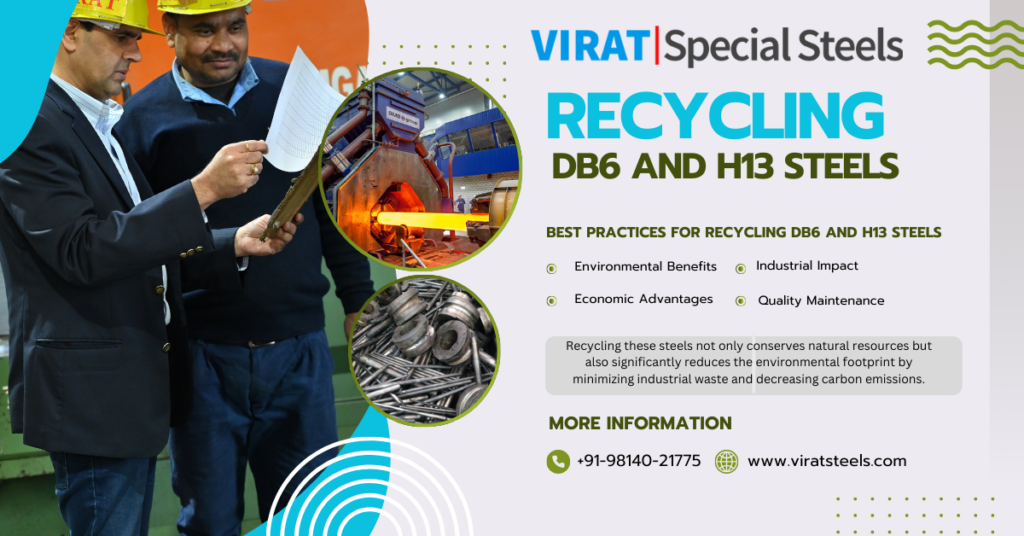
Understanding DB6 and H13 Steels
What is DB6 Steel?
DB6 is a hot work tool steel known for its high toughness, wear resistance, and excellent thermal stability. It is widely used in applications such as:
- Die casting
- Forging dies
- Plastic molds
What is H13 Steel?
H13 is another hot work tool steel, but it is recognized for its high strength, shock resistance, and superior heat resistance. It is commonly used in:
- High-pressure die casting
- Extrusion dies
- Cutting tools
Why Are These Steels Preferred?
Both DB6 and H13 are extensively used due to their long lifespan, excellent mechanical properties, and ability to withstand high temperatures. However, their wide usage also means significant material waste if not recycled efficiently, making sustainability a key concern.
Importance of Recycling DB6 and H13 Steels
Recycling DB6 and H13 tool steels provides numerous environmental, economic, and industrial benefits, such as:
Environmental Benefits
- Reduction in Mining Activities: Less reliance on mining for raw materials, leading to lower deforestation and soil degradation.
- Lower Carbon Footprint: Recycling steel emits less CO₂ compared to new steel production.
- Waste Reduction: Prevents discarded tools and machine parts from ending up in landfills.
Economic Advantages
- Cost Savings: Recycled steel is cheaper to process compared to producing new steel from iron ore.
- Job Creation: The recycling industry generates employment opportunities in steel collection, processing, and re-manufacturing.
Industrial Impact
- Reliable Supply Chain: Reduces dependency on fluctuating raw material markets.
- Quality Maintenance: Ensures industries maintain consistent material properties without resource depletion.
Best Practices in Recycling DB6 and H13 Steels
To ensure effective recycling of DB6 and H13 steels, industries should follow these best practices:
1. Collection and Sorting of Scrap
- Segregate DB6 and H13 steel scraps based on composition and purity.
- Remove contaminants such as coatings, oils, and residual chemicals before recycling.
2. Efficient Melting and Refining Processes
- Use energy-efficient furnaces such as electric arc furnaces (EAFs) for melting steel scrap.
- Introduce vacuum degassing techniques to eliminate impurities and enhance steel quality.
3. Minimizing Energy Consumption
- Utilize waste heat recovery systems to optimize energy usage during melting.
- Improve process automation to reduce excess energy loss.
The Role of Sustainable Steel Production
Sustainability in DB6 and H13 steel production goes beyond just recycling. Manufacturers must also adopt eco-friendly practices to ensure a minimal carbon footprint.
1. Energy-Efficient Manufacturing
- Use electric arc furnaces (EAFs) instead of traditional blast furnaces.
- Upgrade equipment and technology for better process efficiency.
2. Reducing Carbon Emissions
- Implement low-carbon production techniques, such as using hydrogen instead of coal.
- Reduce waste production through lean manufacturing principles.
3. Use of Renewable Energy
- Switch to renewable power sources, such as solar or wind energy, in manufacturing plants.
Challenges in Recycling DB6 and H13 Steels
Despite the advantages, recycling DB6 and H13 steels comes with several challenges:
1. Contamination Issues
- Impurities such as paint, coatings, and lubricants can alter the quality of recycled steel.
2. High Recycling Costs
- Advanced sorting and refining processes require costly equipment and technology.
3. Technological Limitations
- Some recycling facilities lack the necessary machinery to process tool steels effectively.
4. Market Demand for Recycled Steel
- Industries prefer virgin steel due to consistent material properties, making the demand for recycled DB6 and H13 relatively low.
Innovations in Steel Recycling
Technological advancements are transforming DB6 and H13 steel recycling.
1. AI-Based Scrap Sorting
- Automated sorting systems use AI and sensors to classify scrap based on chemical composition.
2. Eco-Friendly Melting Technologies
- Innovations such as plasma arc furnaces enhance steel melting efficiency.
3. Closed-Loop Recycling
- Encourages industries to reuse steel waste internally to minimize material loss.
4. Sustainable Alloying Techniques
- Research focuses on developing alternative alloy compositions with improved recyclability.
Regulatory Compliance and Sustainability Standards
Global standards promote sustainable steel recycling:
1. Government Regulations
- Policies such as extended producer responsibility (EPR) require manufacturers to manage steel waste efficiently.
2. International Standards (ISO 14001, ISO 50001)
- ISO 14001: Guidelines for environmental management systems.
- ISO 50001: Framework for improving energy efficiency in steel production.
3. Industry Best Practices
- Leading steel producers follow green manufacturing protocols to align with climate action goals.
The Future of Sustainable Steel Production
The steel industry is embracing sustainable and innovative solutions:
1. Green Steel Manufacturing
- Companies are shifting towards hydrogen-based steel production, reducing carbon emissions.
2. Circular Economy Integration
- Instead of linear waste disposal, manufacturers are adopting closed-loop recycling models.
3. Carbon Capture in Steel Production
- Emerging carbon capture and storage (CCS) technologies help trap emissions before they enter the atmosphere.
Conclusion
The recycling and sustainability of DB6 and H13 steels are essential for reducing industrial waste, conserving resources, and minimizing environmental impact. By following best practices, such as efficient collection, processing, and adoption of green technologies, industries can enhance sustainability while maintaining cost-efficiency.
The future of sustainable steel manufacturing lies in embracing innovations, complying with global regulations, and shifting towards eco-friendly production methods. Every effort in steel recycling brings us one step closer to a greener planet!
FAQs
1. Why is recycling DB6 and H13 steels important?
Recycling these steels reduces waste, lowers production costs, and helps conserve natural resources and energy.
2. What challenges exist in recycling tool steels?
Common challenges include contamination, high recycling costs, technological limitations, and fluctuating market demand.
3. What are the best methods for improving steel recycling efficiency?
Using advanced sorting technologies, energy-efficient melting processes, and closed-loop recycling systems helps optimize efficiency.
4. How does sustainable steel production impact the environment?
It reduces carbon emissions, conserves energy, and minimizes industrial waste, contributing to a healthier planet.
5. What is the future of sustainable steel recycling?
The future includes green hydrogen-based production, circular economy models, and carbon capture technologies for a low-carbon steel industry.
Applications of H13 Steel in Aerospace and Defense Industries
H13 steel is a versatile tool steel with exceptional properties such as heat resistance, toughness, and wear resistance, making it a popular choice for industries requiring high performance. Its ability to retain its properties under extreme temperatures and stress makes it a staple in aerospace and defense sectors.
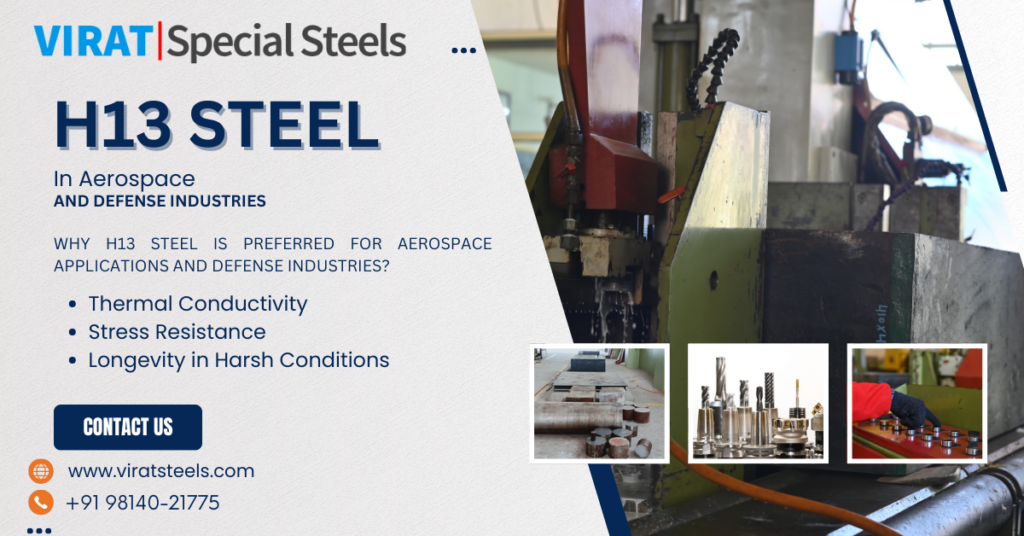
Overview of H13 Steel Composition and Properties
H13 steel is primarily composed of chromium, molybdenum, and vanadium, providing:
- High strength: Resilience to intense forces.
- Heat resistance: Suitable for high-temperature environments.
- Wear resistance: Longevity under constant use.
This unique composition equips H13 steel to meet the challenges of demanding industrial applications.
Importance of H13 Steel in Industrial Applications
Industries rely on H13 steel for its adaptability in high-performance contexts. Its structural integrity, even under stress, ensures operational efficiency and cost-effectiveness over time.
Why H13 Steel Is Preferred for Aerospace Applications
In aerospace, material performance is critical. H13 steel delivers advantages that align with the sector’s stringent demands.
Key Properties of H13 Steel Advantageous for Aerospace
- Thermal Conductivity: Ensures stability during rapid temperature changes.
- Stress Resistance: Retains structure under high pressure.
Types of Aerospace Components Made with H13 Steel
- Engine Parts: Endure high temperatures and mechanical stress.
- Aerospace Tooling Equipment: Crucial for precision in manufacturing processes.
Applications of H13 Steel in Aerospace Industries
Heat-Resistant Aerospace Engine Components
The aerospace industry requires materials that endure extreme heat during operation, such as jet engine turbines and rocket nozzles. H13 steel’s ability to resist thermal degradation ensures consistent performance even in these high-stress environments.
Aircraft Tooling and Manufacturing Dies
Precision is non-negotiable in aerospace manufacturing. H13 steel is indispensable for crafting tools and dies that remain accurate across extensive production cycles. This minimizes downtime and increases productivity.
Why H13 Steel Is Ideal for Defense Applications
H13 steel is a go-to material for defense applications where reliability and strength are essential.
Robustness and Reliability Under Tough Conditions
Military equipment often operates under harsh conditions, from arid deserts to frigid Arctic zones. H13 steel withstands these extremes, ensuring longevity and performance in defense scenarios.
Versatility of H13 Steel in Defense
From crafting ballistic components to manufacturing military vehicles, the adaptability of H13 steel is unparalleled. Its ability to handle high stress without deformation makes it an ideal candidate for a variety of defense-related uses.
Future Outlook for H13 Steel in Aerospace and Defense
The future of H13 steel in these industries looks promising as the demand for high-performance materials continues to grow.
Predicted Growth in Applications
With the expansion of aerospace technology, such as hypersonic aircraft and reusable rockets, the demand for materials that offer excellent thermal and mechanical properties will increase. Similarly, advanced defense projects will rely heavily on the performance reliability of H13 steel.
Evolving Material Enhancements
Research in material science is leading to improved variants of H13 steel with higher stress resistance, reduced weight, and better machinability. These advancements will further solidify H13’s position as a cornerstone of aerospace and defense manufacturing.
Conclusion
H13 steel has firmly established itself as a key player in the aerospace and defense industries. Its unique properties of heat resistance, toughness, and durability allow it to meet the stringent demands of high-performance environments. From manufacturing jet engines to precision dies in military tooling, its applications demonstrate unmatched reliability and versatility. As innovations continue to refine this material, H13 steel will remain critical to the success and advancement of aerospace and defense technologies.
Mode of Supply:
Virat Special Steels is the largest Supplier & Stockiest of H13 Steel in India. Consult our team who will assist you for H-13/ DIN 2344 / AISI H13 steel query. https://www.viratsteels.com/h13.html
Size Range in Forged / Rolled Bars:
Rounds: 13mm Dia to 1500mm Dia
Rectangular: Thickness 13mm – 500mm / Width 13mm to 1500mm
For more information or to discuss your steel needs, Virat Special Steels invites you to reach out through their contact details provided, ensuring a professional and informative experience.
Any further queries feel free to contact us :
🌐https://www.viratsteel.in 📬 info@viratsteels.com ☎+91 98140-21775
FAQs on H13 Steel Applications
1. What makes H13 steel unique compared to other steels?
H13 steel’s high heat resistance, durability, and wear resistance set it apart, making it ideal for extreme environments like aerospace and defense applications.
2. What are the cost implications of using H13 steel in aerospace?
While the initial costs of H13 steel may be higher, its longevity and reduced maintenance requirements offer excellent long-term cost-effectiveness.
3. Is H13 steel environmentally friendly for defense industries?
Innovations like eco-friendly manufacturing processes and recyclable materials are helping make H13 steel more sustainable.
4. How does H13 steel handle high temperatures?
Thanks to its exceptional thermal conductivity and resistance to heat cycling, H13 steel maintains stability and performance under extreme heat.
5. What are the future innovations anticipated for H13 steel?
Expected advancements include enhanced alloy compositions, better weight-to-strength ratios, and sustainable manufacturing processes.
H13 Steel for Die Casting: Key Benefits You Should Know
H13 steel stands as a cornerstone in the die casting industry. Known for its exceptional heat resistance and toughness, this versatile hot-work tool steel is widely used in demanding environments. As die casting often involves high-pressure and extreme thermal conditions, choosing the right material for dies is critical. Enter H13 steel – the ultimate material to enhance durability, improve performance, and maximize efficiency in casting operations.
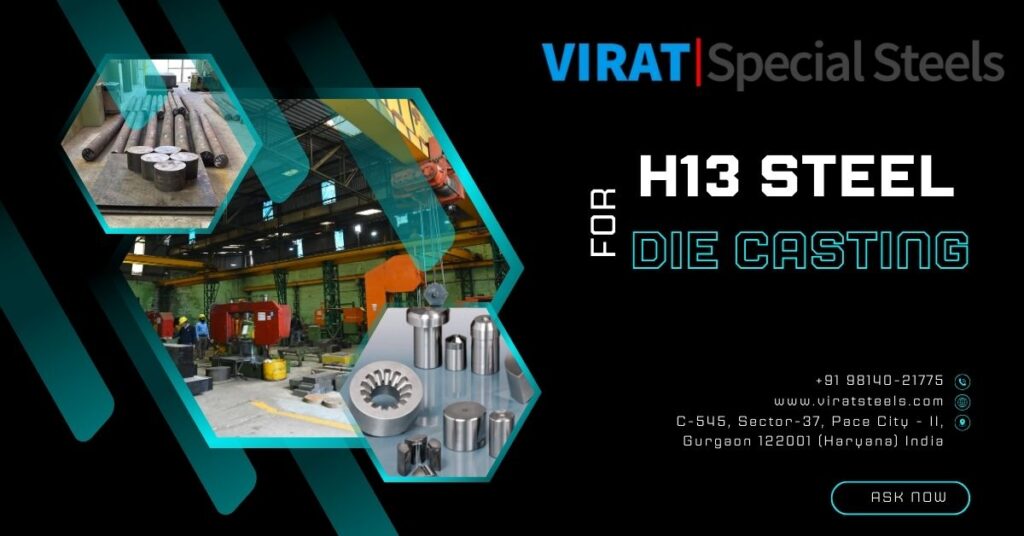
What sets H13 steel apart from the rest? Its outstanding properties make it highly sought after for both small-scale and large-scale die casting applications. But let’s dig deeper into what makes it so special.
Composition and Properties of H13 Steel
Chemical Composition
H13 steel is an alloy comprising a mix of critical elements that optimize its performance. Here’s a breakdown of its main components:
- Chromium (5%): Enhances corrosion resistance.
- Molybdenum (1.4%): Improves hardness and high-temperature strength.
- Vanadium (1%): Increases wear resistance and toughness.
- Carbon (0.4%): Adds strength and hardenability.
- Silicon (1%): Boosts resistance to oxidation.
Mechanical Properties
H13 steel is known for its high tensile strength, ductility, and excellent thermal conductivity. These properties ensure the material remains reliable under rigorous operating conditions. Additionally, H13 steel demonstrates impressive hardenability, making it an ideal choice for precision die applications.
What Makes H13 Steel Ideal for Die Casting?
Thermal Stability
One of the standout features of H13 steel is its remarkable thermal stability. In die casting, molds must endure rapid temperature fluctuations without cracking or deforming. H13’s ability to retain strength at elevated temperatures makes it indispensable.
Resistance to Thermal Fatigue
When dies repeatedly heat and cool during the casting cycle, they are prone to thermal fatigue. H13 steel offers resistance to such stresses, extending the lifespan of the tooling and reducing operational downtime.
Key Benefits of H13 Steel in Die Casting
1. Durability Under High Temperatures
Die casting requires materials that can handle intense heat without losing integrity. H13 steel delivers exceptional performance in such scenarios, maintaining structural stability even under prolonged exposure to molten metals.
2. Excellent Wear Resistance
The abrasive nature of die casting operations can wear down weaker materials quickly. With its robust wear resistance, H13 steel minimizes maintenance needs and offers long-lasting performance.
3. Cost-Effectiveness in Long Production Runs
Although the initial investment in H13 steel may be higher, its durability and resistance to damage translate into significant cost savings over time. Long production cycles benefit greatly from its ability to perform without frequent replacements or repairs.
Longevity and Durability of H13 Steel Dies
Improved Tool Life
When it comes to tooling materials, longevity matters. H13 steel excels in providing longer service life, reducing the need for frequent replacements. Its resilience against wear and deformation significantly adds to the efficiency of the production process.
Resistance to Deformation
Under the extreme pressures of die casting, lesser materials may deform, leading to suboptimal casting results. H13 steel’s resistance to deformation ensures precision and repeatability across countless cycles.
Challenges and Limitations of H13 Steel
Cost Considerations
While H13 steel is cost-effective in the long run, its upfront cost may deter smaller manufacturers. Investing in H13 tooling requires foresight and planning to maximize its return on investment.
Potential Limitations in Specific Environments
H13 steel thrives under high temperatures, but in applications involving extremely corrosive materials or environments, alternative alloys with specific properties might be better suited.
Future Trends in Die Casting Using H13 Steel
Advances in Steel Technologies
Research and innovation are leading to improved formulations of H13 steel with enhanced properties like higher thermal resistance and lower environmental impact. Such developments will further cement H13’s place in the future of die casting.
Emerging Applications and Industries
With rapid advancements in technology, H13 steel’s applications are expanding beyond traditional die casting. Sectors like robotics and renewable energy are beginning to explore its potential, showcasing the steel’s enduring versatility.
Conclusion
H13 steel has revolutionized the die casting industry with its unmatched thermal stability, wear resistance, and adaptability. From improving tool longevity to delivering consistent, high-quality results, it’s clear why this alloy is the material of choice for demanding casting operations. By investing in H13 steel, manufacturers can elevate their production standards, reduce costs over time, and lead the way in sustainable manufacturing.
FAQs
1. Why is H13 steel commonly used in die casting?
H13 steel is ideal for die casting due to its thermal stability, resistance to wear and deformation, and long service life. It is especially effective in high-temperature, high-pressure applications.
2. Can H13 steel be recycled?
Yes, H13 steel is 100% recyclable, making it a sustainable choice for manufacturers committed to reducing waste.
3. How does H13 steel compare to P20 steel?
H13 steel offers superior heat resistance and durability compared to P20, making it more suitable for demanding die casting operations.
4. What industries use H13 steel dies?
H13 steel is widely used in industries such as automotive, aerospace, electronics, and general manufacturing for creating precision die-cast components.
5. What maintenance is required for H13 steel dies?
Regular preventive maintenance, including cleaning, inspections, and refurbishments, is essential to extend the lifespan of H13 steel dies and ensure optimal performance.
Virat Special Steels: A Leader in H13 Steel Supplies
Virat Special Steels is a renowned name in delivering high-quality tool steels, including H13. With decades of industry expertise, Virat has built a reputation for reliability and superior service. Industries across automotive, aerospace, and plastic molding trust Virat for their steel requirements.
Virat Special Steels is the largest Supplier & Stockiest of H13 Steel in India. Consult our team who will assist you for H-13/ DIN 2344 / AISI H13 steel query. https://www.viratsteels.com/h13.html
Size Range in Forged / Rolled Bars:
Rounds: 13mm Dia to 1500mm Dia
Rectangular: Thickness 13mm – 500mm / Width 13mm to 1500mm
For more information or to discuss your steel needs, Virat Special Steels invites you to reach out through their contact details provided, ensuring a professional and informative experience.
Any further queries feel free to contact us :
🌐https://www.viratsteel.in 📬 info@viratsteels.com ☎+91 98140-21775
H13 Tool Steel Hardness: Methods to Test and Optimize Performance
Introduction
H13 tool steel stands out for its remarkable durability and thermal resistance, making it a preferred choice in industries such as automotive, aerospace, and manufacturing. However, its effectiveness hinges on maintaining optimal hardness, which directly impacts wear resistance, toughness, and performance under stress. This article explores various methods for testing H13 steel hardness and strategies to optimize it for maximum utility.
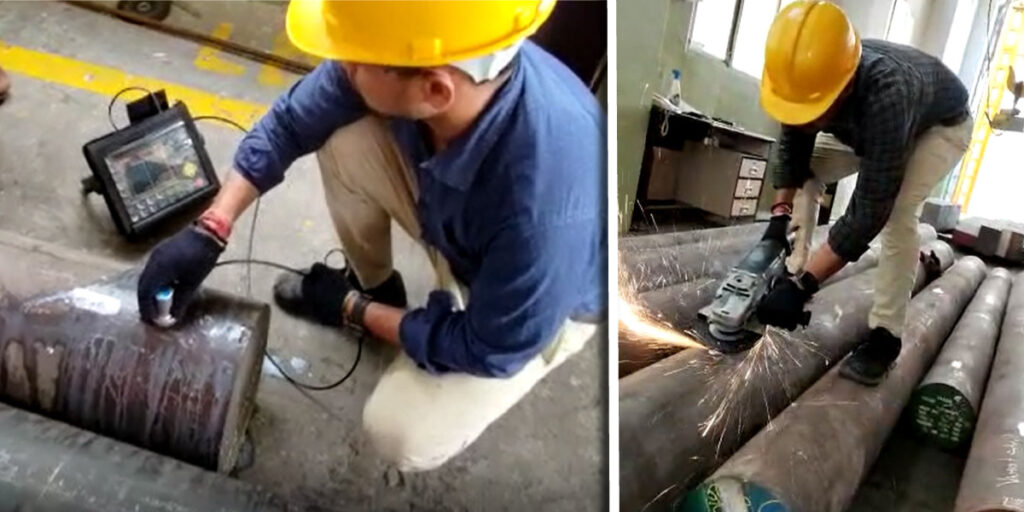
What is H13 Tool Steel?
H13 is a chromium-molybdenum hot work tool steel renowned for its exceptional strength and heat resistance. It contains:
- Chromium for enhanced corrosion resistance.
- Molybdenum and vanadium for superior toughness and wear resistance.
H13’s properties make it ideal for applications like:
- Forging dies.
- Injection molding tools.
- Extrusion dies.
- Die-casting components.
This robust tool steel withstands thermal fatigue, making it invaluable in environments with rapid temperature fluctuations.
Read More >What Industries Benefit the Most from Using H13 Steel?
Introduction
In the vast world of industrial materials, few tool steels have made as significant an impact as H13 steel. Renowned for its exceptional durability, heat resistance, and machinability, H13 steel stands as a cornerstone in industries requiring high-performance materials. From automotive manufacturing to plastic molding, this versatile steel helps businesses thrive by enhancing productivity and ensuring long-term efficiency.
Whether you’re an industry expert or a curious reader, understanding the benefits and applications of H13 steel sheds light on why it is so widely celebrated. Let’s explore what makes H13 steel an indispensable choice for various industries.
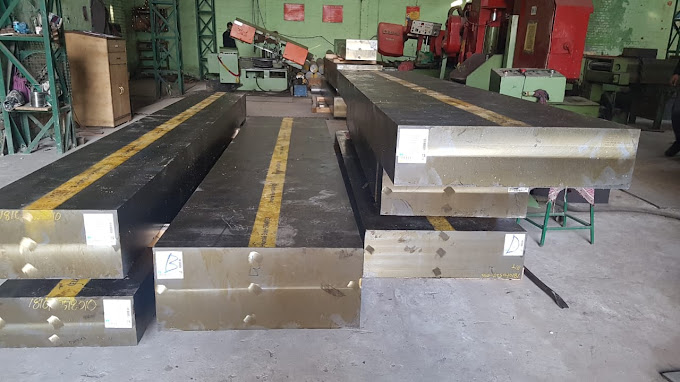
Understanding H13 Steel
What Is H13 Steel?
H13 steel is a chromium-molybdenum hot-work tool steel that offers exceptional strength and resistance to thermal fatigue. Classified as an H-grade steel, it is specially engineered for high-temperature applications. Its unique composition includes:
- Carbon: Provides hardness.
- Chromium and Molybdenum: Enhance toughness and heat resistance.
- Vanadium: Adds wear resistance.
Unique Characteristics of H13 Steel
H13 steel’s distinguishing properties make it one of the most trusted materials for heavy-duty industrial purposes:
- High thermal stability and resistance to cracking under thermal cycling.
- Exceptional machinability and ease of finishing.
- Outstanding toughness and abrasion resistance.
Common Applications in Industry
From manufacturing molds to constructing durable tools, H13 steel has applications across various demanding environments. It’s especially suited for high-heat tasks, such as die-casting and injection molding.
The Importance of H13 Steel in Industrial Sectors
In today’s competitive market, industries are constantly on the lookout for materials that can endure intense conditions without compromising efficiency. H13 steel has earned a reputation for its ability to reduce downtime and extend the lifespan of tools. Its versatility and reliability allow companies to deliver products that meet rigorous performance standards.
Industries That Benefit the Most from H13 Steel
Automotive Industry
The automotive sector thrives on precision and durability, and H13 steel plays an integral role in achieving these goals. The material’s heat resistance and toughness make it a prime choice for:
- Die-casting molds: Creating engine parts and automotive components.
- High-temperature tools: Handling demanding manufacturing processes without deforming or cracking.
Aerospace Industry
Aviation demands high precision and reliability. H13 steel contributes to the aerospace industry by being an ideal material for:
- Forging dies and cutting tools.
- Heat-treated aviation components that endure extreme stress and temperature changes.
Plastic Molding and Manufacturing
In the realm of plastic production, injection molds are under constant pressure to perform efficiently. H13 steel ensures the longevity and quality of:
- Injection molds: That shape plastics for consumer goods.
- Tooling parts: That resist wear from continuous production cycles.
Die-Casting Industry
The die-casting sector relies heavily on H13 steel for its ability to withstand molten metals. It’s an essential material for:
- High-performance casting molds for aluminum, zinc, and magnesium.
- Precision tools that resist thermal cycling and erosion.
Construction and Heavy Equipment
Heavy industries demand tools and parts that endure tremendous mechanical stress. H13 steel finds its place in:
- Specialized construction machinery parts.
- Tools used in mining and heavy lifting.
Benefits of Using H13 Steel for These Industries
- High Heat Resistance: Maintains its shape and properties under extreme temperatures.
- Durability and Toughness: Resists deformation and cracking under heavy loads.
- Cost Efficiency: Reduces tool replacements and downtime, saving companies money in the long run.
Challenges in Using H13 Steel
Like all materials, H13 steel has challenges:
- Machining Difficulties: Requires skilled handling for optimal results.
- Heat Treatment Needs: Proper treatment is necessary to ensure performance.
- Cost Considerations: While initial costs are high, long-term savings often outweigh this drawback.
Tips for Selecting and Maintaining H13 Steel
- Choose Trusted Suppliers: Ensure quality by sourcing H13 steel from reliable manufacturers like Virat Special Steels.
- Prioritize Heat Treatment: Proper treatment enhances longevity and performance.
- Regular Maintenance: Periodically inspect tools and parts to ensure optimal operation.
Virat Special Steels: A Leader in H13 Steel Supplies
Virat Special Steels is a renowned name in delivering high-quality tool steels, including H13. With decades of industry expertise, Virat has built a reputation for reliability and superior service. Industries across automotive, aerospace, and plastic molding trust Virat for their steel requirements.
Future Trends and Applications of H13 Steel
Advancements in technology continue to unlock new applications for H13 steel, from cutting-edge aerospace innovations to enhanced 3D printing tools. As industries demand more from their materials, H13 steel is expected to remain a cornerstone of industrial growth.
Conclusion
H13 steel is a true industrial powerhouse, serving as a backbone for industries requiring unmatched durability and heat resistance. Its applications across automotive, aerospace, die-casting, and more make it indispensable in achieving quality and performance. For businesses looking to enhance their productivity, H13 steel, supplied by trusted names like Virat Special Steels, remains a wise investment.
FAQs
1. What sets H13 steel apart from other tool steels?
H13 steel offers unmatched heat resistance and durability, making it ideal for high-temperature and high-stress applications.
2. How does H13 steel contribute to cost savings in industries?
Its long lifespan reduces the need for frequent replacements, saving money over time.
3. Can H13 steel be recycled for industrial use?
Yes, H13 steel is recyclable, contributing to sustainable industrial practices.
4. What types of maintenance are needed for H13 steel tools?
Regular inspections, timely heat treatments, and cleaning to avoid contamination can ensure prolonged efficiency.
5. Where can industries procure high-quality H13 steel?
Reliable suppliers like Virat Special Steels specialize in delivering premium-grade H13 steel for diverse industrial needs.
Virat Special Steels is the largest Supplier & Stockiest of H13 Steel in India. Consult our team who will assist you for H-13/ DIN 2344 / AISI H13 steel query. https://www.viratsteels.com/h13.html
Size Range in Forged / Rolled Bars:
Rounds: 13mm Dia to 1500mm Dia
Rectangular: Thickness 13mm – 500mm / Width 13mm to 1500mm
For more information or to discuss your steel needs, Virat Special Steels invites you to reach out through their contact details provided, ensuring a professional and informative experience.
Any further queries feel free to contact us :
🌐https://www.viratsteel.in 📬 info@viratsteels.com ☎+91 98140-21775
Why H13 Steel is Ideal for Hot Work Tool Applications?
When it comes to hot work tool applications, durability, heat resistance, and toughness are crucial. Among the range of available materials, H13 steel consistently stands out as a top choice. Known for its exceptional properties, H13 is widely used across industries for die-casting, forging, and extrusion applications. Let’s delve deeper into what makes H13 steel ideal for such demanding environments.
Introduction to H13 Steel
Overview of Tool Steels
Tool steels are specially designed to handle extreme conditions, whether it’s the heat in hot work applications or stress in cutting and machining. They are classified into types like hot work, cold work, and plastic mold steels based on their intended applications. These steels are manufactured with alloying elements to impart specific qualities like wear resistance, toughness, and thermal conductivity.
What Makes H13 Steel Unique?
H13 steel is a chromium-molybdenum-vanadium alloy, which sets it apart as a hot work tool steel. It’s the balance of heat resistance, toughness, and wear resistance that makes H13 an industry favorite. With a reputation for excellent machinability, resistance to thermal fatigue, and exceptional durability, H13 ensures reliable performance in the harshest environments.
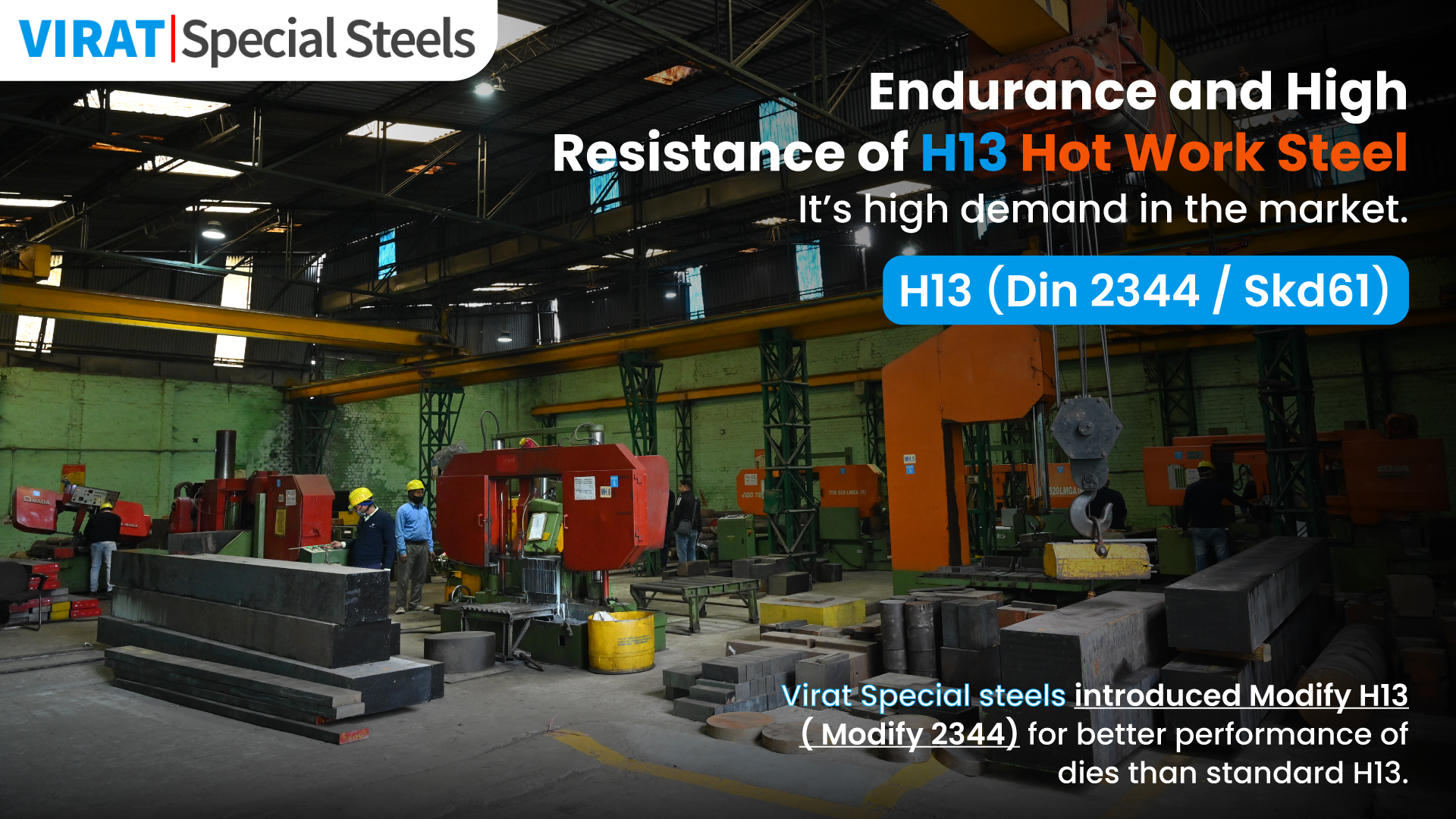
Properties of H13 Steel That Make it Suitable for Hot Work
High Thermal Resistance
H13 steel is renowned for its ability to withstand high operating temperatures without deforming. This property is particularly valuable in hot work applications like die-casting and forging, where tools are exposed to prolonged heat cycles.
Excellent Toughness
What makes H13 exceptional is its ability to endure immense pressure and impact without cracking. This toughness not only prolongs the tool’s lifespan but also improves operational safety.
Resistance to Thermal Fatigue
Repeated heating and cooling cycles can degrade many materials, but H13 shines in this area. Its thermal fatigue resistance ensures consistent performance over time, even in extreme conditions like die-casting where rapid temperature changes occur frequently.
Applications of H13 Steel in Hot Work Tools
Die-Casting Molds
In die-casting, molten metals are injected into molds to create precision parts. H13 steel’s ability to endure the high temperatures and pressures involved makes it the perfect choice for this application.
Forging Dies
The forging process involves shaping metals under intense heat and pressure. H13’s toughness and wear resistance ensure that dies made from this material maintain their integrity and accuracy over time.
Extrusion Dies
Extrusion processes subject dies to prolonged heat and force. H13 steel, with its superior heat resistance and durability, ensures smooth operations and minimizes downtime in this challenging application.
Comparison of H13 with Other Tool Steels
H13 vs. D2 Steel
While D2 steel is excellent for wear resistance in cold work, it lacks the high-temperature strength of H13. For hot work applications, H13 is the preferred option.
H13 vs. P20 Steel
P20 is widely used in plastic mold applications, but it cannot handle the extreme heat and thermal fatigue associated with hot work. H13, in contrast, thrives in high-temperature environments.
Advantages of Using H13 Steel in Toolmaking
Cost-Effectiveness
Although H13 steel may have a higher upfront cost, its longer service life and superior performance in demanding conditions make it a cost-effective choice in the long run.
Performance Consistency
Industries rely on H13 steel because it delivers consistent results in extreme conditions. This reliability ensures smooth operations and minimizes production losses.
Versatility
While H13 shines in hot work applications, its qualities make it suitable for other uses, including cold work to some extent, adding to its versatility.
Challenges and Maintenance of H13 Steel
Common Challenges
Despite its robust properties, H13 steel is not immune to wear and tear. Prolonged exposure to oxidation and improper heat treatment can impact its performance.
Proper Maintenance Practices
Proper maintenance, such as routine inspections, heat treatments, and ensuring an adequate cooling system, is essential for maximizing the tool life of H13 steel.
Selecting the Right H13 Steel
Importance of Quality
Not all H13 steel is created equal. Choosing a reliable supplier ensures the steel meets industry standards and delivers the desired performance.
Why Virat Special Steels Is Your Trusted Partner
Virat Special Steels is a leading name in delivering high-quality H13 steel tailored for diverse industrial needs. Their commitment to quality and technical expertise makes them the go-to choice for businesses across the globe.
Conclusion
H13 steel sets the standard for hot work applications, offering unmatched durability, heat resistance, and reliability. From die-casting to forging, its exceptional properties ensure that tools perform optimally even in the most demanding environments. For businesses that prioritize performance and longevity, H13 steel is a top choice, and Virat Special Steels ensures the highest quality material for your industrial needs.
FAQs
- What makes H13 steel different from other hot work tool steels?
Its unique composition of chromium, molybdenum, and vanadium ensures a perfect balance of heat resistance and toughness. - Can H13 steel be used in cold work applications?
While not specifically designed for cold work, its toughness and wear resistance make it versatile enough for some such uses. - What industries benefit the most from using H13 steel tools?
Industries like automotive, aerospace, and manufacturing rely heavily on H13 steel for die-casting and forging applications. - How does heat treatment impact the performance of H13 steel?
Proper heat treatment enhances the durability, toughness, and fatigue resistance of H13 steel, ensuring it performs consistently under stress. - Why choose Virat Special Steels for H13 steel?
Virat Special Steels offers unmatched quality and expertise, delivering H13 steel that meets stringent industrial standards.
Contact us today to learn more about how H13 tool steel can serve your production needs and help your business achieve optimal efficiency and precision.
Partner with Virat Special Steels for quality, expertise, and reliable H13 solutions.
Whether you’re in the market for robust H13 tool steel or exploring the best options for your next project, #ViratSpecialSteels has got you covered!
Virat Special Steels, INDIA!
https://www.viratsteels.com/h13.html
📞 Contact us today to learn more about how we can support your business!
https://www.viratsteel.in/special-steel-supply-networks/
Any further queries feel free to contact us :
🌐https://www.viratsteels.com/ 📬 info@viratsteels.com ☎+91 98140-21775
H13 Steel: A Comprehensive Guide by Virat Special Steels
Overview of H13 Steel
H13 Steel is a versatile hot-work tool steel highly regarded for its durability, resistance to thermal fatigue, and exceptional strength under high temperatures. This steel type plays a vital role in various industries, from manufacturing heavy-duty dies to precision machining applications. Thanks to its unique properties, H13 Steel stands as one of the most trusted materials in both high-stress and high-temperature environments.
Significance of H13 Steel in Various Industries
Whether it’s the aerospace sector, die-making, or automotive components manufacturing, H13 Steel provides the reliability and resilience these industries demand. Virat Special Steels supplies this high-grade steel in various formats, catering to diverse business requirements. Its availability in sheets, plates, and round bars ensures clients get tailor-made solutions.
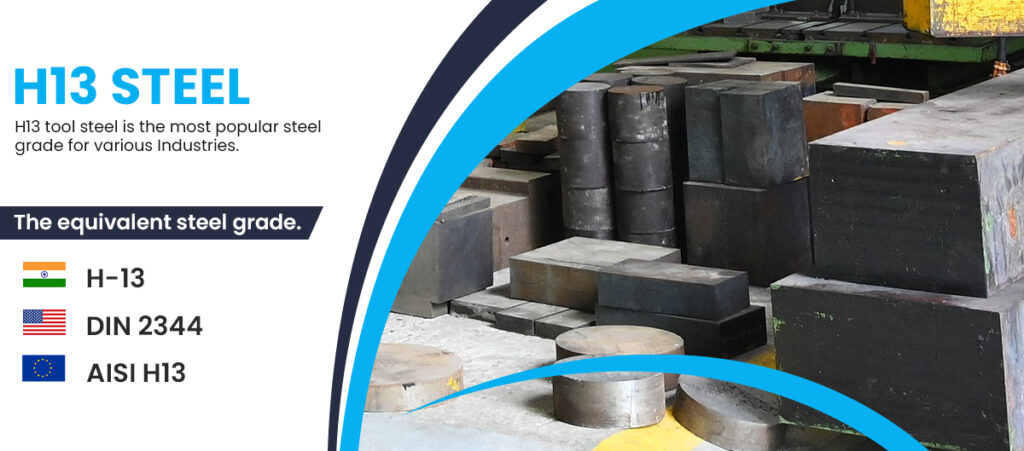
Key Features of H13 Steel
What Makes H13 Steel Unique?
H13 Steel is characterized by its:
- Exceptional heat resistance.
- High toughness and tensile strength.
- Prolonged tool life due to abrasion resistance.
These features make it ideal for forging, die-casting molds, and extrusion dies, giving manufacturers a reliable solution for high-temperature applications.
Applications of H13 Steel in the Manufacturing Sector
Industries trust H13 Steel for critical operations such as:
- Die-casting: Durable under extreme heat, making it perfect for molds.
- Automotive Tools: Precision parts for gears and shafts.
- Forging Dies: Heat-resistance for consistent long-term usage.
H13 Steel Chemical Composition and Mechanical Properties
H13 Steel Chemical Composition
The chemical composition of H13 Steel includes key elements:
| Element | Percentage |
| Carbon (C) | 0.32-0.45% |
| Chromium (Cr) | 4.75-5.50% |
| Molybdenum (Mo) | 1.10-1.75% |
| Vanadium (V) | 0.80-1.20% |
| Silicon (Si) | 0.80-1.20% |
These elements contribute to its superior heat resistance and strength.
H13 Steel Mechanical Properties
Key mechanical features of H13 Steel are:
- Hardness (HRC): 48-54.
- Tensile Strength: 2800 MPa.
- Good machinability and polishability.
H13 Steel Types and Availability
H13 Steel Plates and Sheets
Virat Special Steels offers H13 Steel plates and sheets that cater to different industrial needs, including mold manufacturing and heavy equipment production. These materials can endure extreme conditions while retaining structural integrity.
H-13 Steel Round Bar
The H-13 Steel Round Bar is a popular format used for precision machining and heavy-duty applications. Virat Special Steels ensures superior surface finish and precise dimensions in their round bars.
H-13 Steel Square and Flat Bars
Flat bars and square bars are sought-after for crafting large molds and cutting tools. Their customizable dimensions provide tailored solutions to complex engineering requirements.
H13 Steel Equivalent Grades
Exploring H13 Steel Equivalent Grades Globally
H13 Steel has global equivalents that meet different industry standards:
- AISI H13 (USA): Widely recognized in North America.
- X40CrMoV5-1 (Europe): An equivalent under European norms.
- SKD61 (Japan): Known for precise tooling applications.
Understanding these grades helps international businesses ensure consistent material quality.
H13 Steel Manufacturers and Dealers
Top H13 Steel Manufacturers in the Industry
Virat Special Steels collaborates with industry-leading manufacturers to source premium-quality H13 Steel. Their close relationships ensure superior product quality at competitive prices.
Role of H13 Steel Dealers, Distributors, and Stockists
Distributors like Virat Special Steels play a crucial role in ensuring seamless availability across industries. Their inventory spans a broad range of sheets, plates, and bars, meeting high-demand timelines.
Conclusion
H13 Steel remains an invaluable asset in modern manufacturing. From its exceptional thermal resistance to durability under stress, it equips industries with materials that stand the test of time. Choosing reliable suppliers like Virat Special Steels ensures access to top-tier products that match exact business needs.
FAQs
- What is the standard chemical composition of H13 Steel?
H13 Steel is composed of Carbon (0.32-0.45%), Chromium (4.75-5.50%), Molybdenum (1.10-1.75%), and Vanadium (0.80-1.20%). - How is H13 Steel used in die-making?
H13 Steel’s durability and heat resistance make it ideal for manufacturing extrusion and die-casting molds. - What are the benefits of choosing H-13 Steel Round Bars?
Round bars offer superior machinability, making them a top choice for crafting precision components. - Can I get H13 Steel customized for specific applications?
Yes, Virat Special Steels provides customized H13 Steel solutions to meet diverse industrial demands. - How to find trusted H13 Steel dealers near me?
Look for authorized distributors like Virat Special Steels for reliable products and timely delivery.
Locations: Based in Gurgaon (Haryana) & Ludhiana (Punjab), India.
Get in touch with us today to place your requirement!
For more information visit
https://www.viratsteels.com/h13.html
Any further queries feel free to contact us :
🌐https://www.viratsteels.com 📬 info@viratsteels.com ☎+91 98140-21775
Why H13 is the preferred choice?
The physical characteristics of H13 steel are derived from the distinct make and composition of it. The concentration and ratios of different components need to be ensured as required so that the desirable attributes are secured. Failing the same, the molding dies may never deliver as per standards.
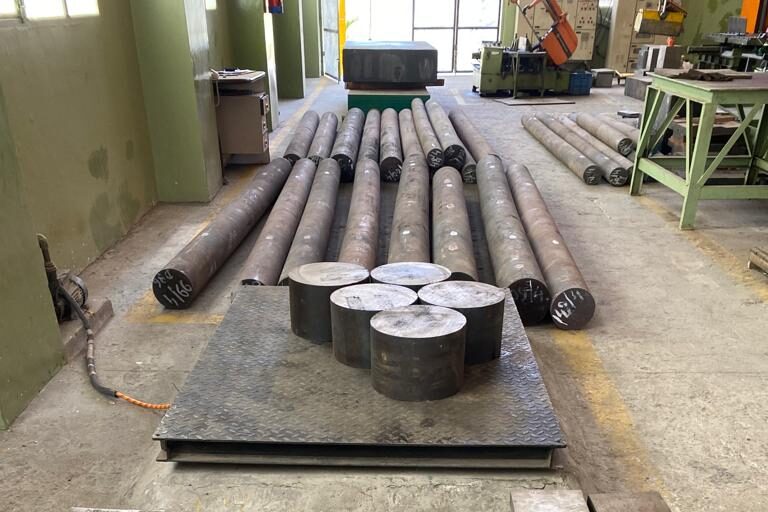
Apart from maintaining specific composition, other processes are also adhered to like annealing and tempering of the steel. H13 steel is forged at 1079 degree centigrade while the minimum forging threshold prescribed for it is 898 degree centigrade. Annealing is done at 871 degree centigrade and tempering of it is performed in the thermal range of 538 – 649 degree centigrade. These processes ensure that high tensile strength and elasticity is generated through the micro arraying of the components in the most even manner.
In fact micro structure of H13 steel is directly responsible for the characteristics that make it the preferred choice as for making hot injection molding, Forging, Extrusion dies etc. The thermal resistance that it offers as regards temperature variation during the injection of material is much superior as compared to other tools and dies steels in the hot work steel category. Virat Special Steels is a pioneer in the manufacture of H13 steel based products including all kinds of dies and moulds and ensures the optimized value by maintaining strict standards.
High applicative value of H13:
With the molding and dies applications growing multifold in the manufacturing economy around the world, H13 has emerged as the top choice. Not only for the hot working but it is also being actively used as cold working steel for tools and moulds. However, it is its capacity to withstand the wear and thermal induced corrosion that 2344 steel has felt wider acceptance in the hot injection molding and tooling applications in manufacturing enterprises. It allows long term use with little maintenance while the finesse and polishing potential that is carries for the finished product is of high standard too. This directly impacts the cost of the final product to be sent in market and ensures economy in production.
Further the ability to offer custom H13 products/moulds can increase productivity for companies that are engaged in making specialized products. www.h13steel.in / Viratsteels.com is a specialty manufacturer of H13 steels and offers highly versatile customized products to Indian and international clients.
To know about more specific details of h13 steel ( 2344 steel ), please visit the website www.h13steel.in / www.viratsteels.com
Any further queries feel free to contact us:
🌐www.viratsteels.com 📬 info@viratsteels.com 📲+91-98140 21775






